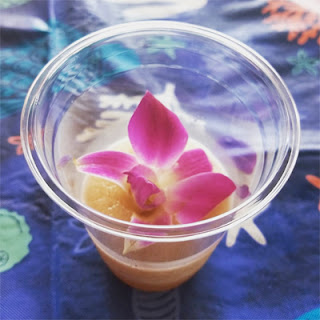3/4 oz Gin (Beefeater)
3/4 oz Sweet Vermouth (Cocchi)
3/4 oz Campari
1/4 oz Curaçao (Pierre Ferrand Dry)
1/4 oz Maraschino (Luxardo)
1/4 oz Lemon Juice
1 dash Angostura Bitters
Shake with ice, strain into a narrow cocktail glass (sub narrow wine glass or small flute) rimmed with sugar, and garnish with a long wide lemon or orange twist (lemon twist) wrapped around the interior of the glass' rim.
Two Thursdays ago in the midst of Negroni Week, I began pondering what Negroni mashups that I could do. My mind set off in a Tiki direction such as I did last year for Negroni Week with the
Negroni on Saturn and as I have done more recently with the
Negroni Grog and the Zombie riff
The Count Rides Again. Somewhere along the line, it dawned on me that a Crusta would be delightful. I had not touched the 1852 vintage structure since last summer with the
Deauville Crusta. In pondering whether to make the added sweetener to balance the citrus and bitters the classic curaçao or the slightly newer Maraschino, I thought "why not both?" akin to what I did with the
Bamboo Crusta years ago. While curaçao would round out the orange flavor in Campari, I have learned from drinks like the
Carnivale (née the Pisco Disco) how Maraschino can soften Campari in the direction of Aperol. Lemon juice and Angostura Bitters were the additions that I went with by routine, and I did consider a wide orange swath for garnish but my orange at home has had too much peel taken off of it to make that happen. I ended up sticking with a lemon peel garnish, but orange would not be out of place here.

The Negroni Crusta greeted the nose with lemon oil over an orange and grape aroma. Next, the sip mirrored the bouquet with lemon, orange, and grape notes, but the swallow took things in a more complex direction with gin, bitter orange, and nutty Maraschino flavors and a clove and allspice finish. Overall, the citrus and liqueurs worked to make this rather gentle for a Negroni-based drink.











 3/4 oz Dark Rum (1 oz Coruba)
3/4 oz Dark Rum (1 oz Coruba)


















 The 2017 collection of 855 drink recipes, bartender tributes, and essays on hospitality from CocktailVirgin's Frederic Yarm. Available at
The 2017 collection of 855 drink recipes, bartender tributes, and essays on hospitality from CocktailVirgin's Frederic Yarm. Available at  The 2012 collection of 505 drink recipes, techniques, and Boston bar recommendations from Frederic Yarm. Available at
The 2012 collection of 505 drink recipes, techniques, and Boston bar recommendations from Frederic Yarm. Available at 




